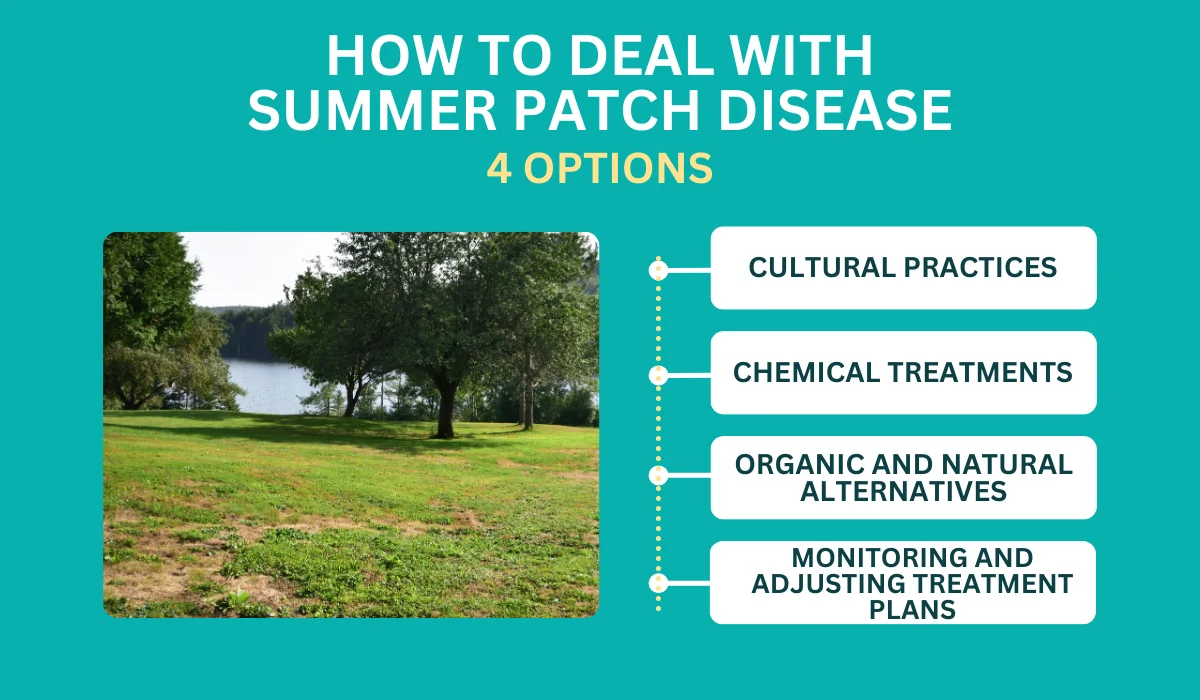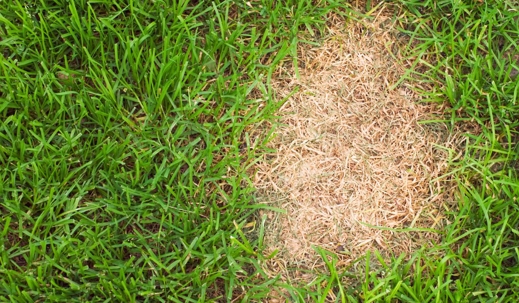How to Deal With Summer Patch Disease in South Florida
Is your South Florida lawn looking a bit rough? Summer patch disease might be the culprit.
This turf trouble is sparked by the lawn fungus Magnaporthe poae, which loves the hot, humid summers here and attacks grass roots, causing ugly brown patches.
Notice your grass wilting or looking brown? Don't wait! Catching this right away is crucial. So read on to discover how to keep your lawn lush and healthy by preventing and treating summer patch disease.
Key Takeaways
- Cultural practices like lawn aeration and proper watering help maintain turf health and prevent summer patch disease.
- Applying preventive and curative fungicides at the right time is crucial for managing summer patch disease effectively.
- Incorporating compost and using biological fungicides offer sustainable ways to improve soil health and control pathogens naturally.
- Regularly inspecting your lawn and adjusting treatment plans based on the condition and weather patterns ensures optimal disease management.
- If, despite all efforts, you still see irregular patches of brown or yellow turf, it's time to consult lawn care experts to manage and recover your lawn effectively.

Option 1: Cultural Practices
Cultural practices are critical in managing turfgrass diseases like summer patch disease in South Florida. These practices aim to maintain lawn health and minimize conditions that favor disease development.
Aeration
Together with dethatching, aeration mitigates summer patch disease by allowing air and water to penetrate the soil, promoting healthy root systems.
Proper aeration reduces excessive thatch buildup, a common issue in dense turf like St. Augustine grass and zoysiagrass that can harbor pathogens.
Here are steps you can follow for proper lawn aeration:
Check soil moisture; it should be damp, not saturated.
Use a core aerator to remove small plugs of soil.
Perform aeration during cooler parts of the day to minimize stress.
Aerate annually or semi-annually, depending on grass species and soil type.
Remove cores from the lawn surface or break them down after aeration.
After aeration, consider overseeding your lawn to improve its density.
Proper Watering
Effective watering practices are essential for preventing summer patch disease. They maintain a balance that supports grass without creating excessively moist conditions that pathogens prefer.
Besides knowing when to water your lawn, following these best watering practices is crucial for South Florida lawns:
Time of Day | Frequency | Notes |
Early morning | Duration varies; 2-3 times per week | Avoid evening watering to reduce prolonged moisture on grass blades. |
Adjust based on rainfall | Duration varies; monitor weather patterns | Supplement natural rainfall to avoid overwatering. |
Adjust based drought | 1 inch per week during dry spells | Ensure deep, infrequent watering to encourage deep root growth. |
Balanced Fertilization
Balanced fertilization can significantly prevent summer patches by enhancing turf vigor and better-equipping grass to resist disease pathogens.
Thus, following a responsible fertilization schedule is essential to avoid excessive nutrient buildup.
Here are some of the recommended fertilizer types and application schedules:
- Use a slow-release nitrogen fertilizer.
- Apply potassium in the late summer or early fall.
- Schedule applications based on the specific lawn grass type.
- Conduct soil tests to determine specific lawn needs.
- Consult with a lawn care professional for a customized fertilization plan.
Adjust Mowing Height
With sharp mower blades, proper mowing height is attainable to help alleviate stress on the turf.
This practice also allows grass blades to develop a more robust root system, particularly in species like bermudagrass and tall fescue.
Here’s a closer look at the optimal mowing heights for different grass types:
Grass Types | Optimal Mowing Height |
St. Augustine grass | 3-4 in. |
Bermudagrass | 1-2 in. |
Zoysiagrass | 2-2.5 in. |
Tall fescue | 2.5-3 in. |
Kentucky bluegrass | 2.5-3 in. |
Bentgrass | 0.5 in. |
Perennial ryegrass | 1.5-2.5 in. |
Option 2: Chemical Treatments
Chemical treatments are essential for managing summer patch disease in South Florida. In addition to pesticides, fungicides also play a critical role in pest control, targeting the pathogen before and after it manifests.
Preventive Fungicide
Preventive fungicides are crucial for stopping Rhizoctonia solani, which may cause large patches, and other pathogens responsible for dollar spots or brown patch disease.
They're particularly effective against fungal diseases that have yet to infiltrate the lawn. However, you must thoroughly diagnose the lawn for early fungal disease symptoms.
Some recommended active ingredients you can use include:
- Azoxystrobin: Apply in late spring or when daytime temperatures reach 80°F.
- Propiconazole: Begin applications in early summer or before high-stress periods.
- Chlorothalonil: Use when there's a forecast of continued warm, humid conditions.
Curative Fungicide
Once summer patch disease is evident, curative fungicides can help stop the spread and mitigate damage. However, they should be part of a broader pest control strategy to tackle pests like chinch bugs.
Here’s a closer look at curative fungicides that work best to address your lawn problem:
Fungicide | Timing of Application |
Fluoxastrobin | At disease onset |
Pyraclostrobin | During active disease |
Trifloxystrobin | When root rot symptoms appear |
Option 3: Organic and Natural Alternatives
Organic and natural alternatives provide a sustainable approach to managing summer patch disease in South Florida lawns.
Compost and Organic Matter
Compost substantially improves lawn soil health, creating an environment for your warm or cool-season turn that is less conducive to summer patch disease.
It introduces beneficial microorganisms that compete with the pathogens responsible for the disease.
Here’s how to incorporate compost into a South Florida lawn:
- Add a thin layer (about 1/4 to 1/2 inch) of high-quality compost over the lawn in the spring.
- Mix compost with topsoil when filling in depressions or establishing a new lawn.
- Use locally sourced organic matter to ensure it's well-suited to the region's soil type and conditions.
- Repeat compost application annually to maintain soil quality and disease resistance.
Biological Fungicides
Biological fungicides are microorganisms or natural substances that can protect season grasses from summer patch disease.
Without the harsh effects of chemical treatments, they work by crowding out or attacking the pathogen directly.
Fungicide Name | Effectiveness | Application Method | Suitable for South Florida |
Bacillus subtilis | High | Spray or granular | Yes |
Trichoderma spp. | Moderate to High | Soil incorporation | Yes |
Streptomyces spp. | Moderate | Spray or drench | Yes |
Option 4: Monitoring and Adjusting Treatment Plans
Implementing a dynamic approach to managing summer patch disease is crucial. Regular checks enable timely intervention, and treatment plan adjustments ensure effective disease control.
Regular Monitoring
Monitoring is essential in catching summer patch disease early, as it can progress rapidly during extended periods of warm weather in late spring to early summer.
As South Florida homeowners, you should be vigilant in inspecting your turfgrass for common signs and symptoms:
- Circular patches: Look for areas where the grass forms circular patterns that can expand over time.
- Brown spots: Keep an eye out for straw-colored or brown grass spots, which could indicate the presence of brown patch fungus.
- Dead grass: Any sudden onset of dead grass within your lawn may signal an outbreak.
Adjustment of Treatment Plans
Based on regular monitoring, treatment plans may require changes to manage summer patch disease in South Florida lawns effectively.
Consider these factors when revising strategies to manage lawn diseases:
Factor | Consideration | Example |
Lawn Condition | Assess the severity of symptoms and affected areas. | Larger or multiple patches might need more aggressive treatment. |
Weather Patterns | Adjust for recent and upcoming weather changes. | Extended periods of heat may necessitate increased fungicide applications. |
Treatment Efficacy | Review past treatment successes and failures. | If current methods are ineffective, switch to alternative treatments. |
When to Seek Professional Help
In sunny South Florida, your lawn is not just grass—it's a personal green oasis. But it can be a real bummer when summer patch disease starts playing the villain.
With this disease, you might notice irregular brown or yellow turf patches despite your best efforts in following lawn care tips.
That's the cue: it might be time to call in the lawn guardians, a.k.a. the lawn care experts (like us, here at Native Pest Management).
As lawn care pros, we are ready to help those grassroots rally and thrive. Let us work our magic—South Florida's lawns deserve to be lush and party-ready all year round!
